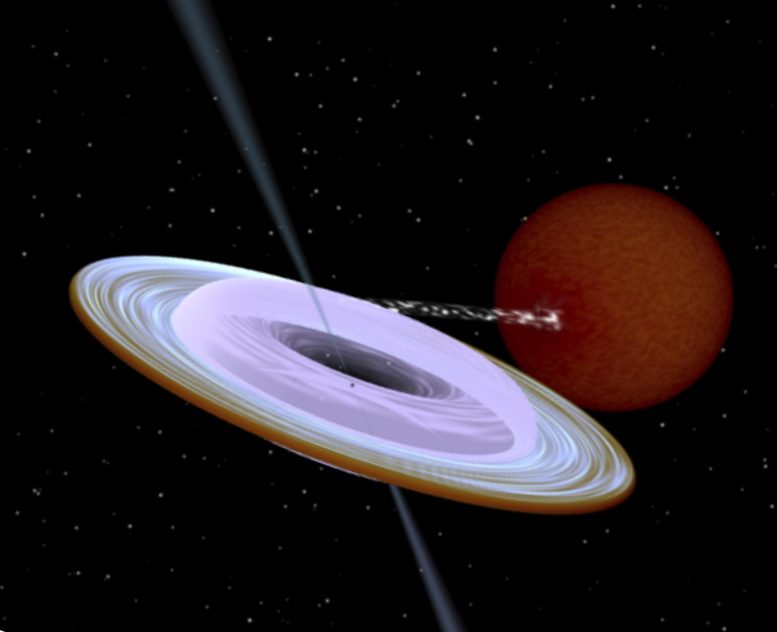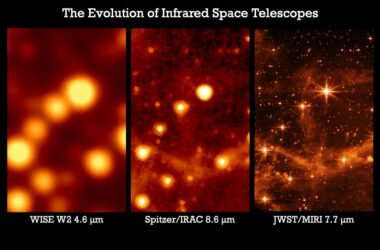Des chercheurs de l’université de Turku, en Finlande, ont découvert que l’axe de rotation d’un black hole in a binary system is tilted more than 40 degrees relative to the axis of stellar orbit. The finding challenges current theoretical models of black hole formation.
The observation by the researchers from Tuorla Observatory in Finland is the first reliable measurement that shows a large difference between the axis of rotation of a black hole and the axis of a binary system orbit. The difference between the axes measured by the researchers in a binary star system called MAXI J1820+070 was more than 40 degrees.

Artist impression of the X-ray binary system MAXI J1820+070 containing a black hole (small black dot at the center of the gaseous disk) and a companion star. A narrow jet is directed along the black hole spin axis, which is strongly misaligned from the rotation axis of the orbit. Image produced with Binsim. Credit: R. Hynes
Often for the space systems with smaller objects orbiting around the central massive body, the own rotation axis of this body is to a high degree aligned with the rotation axis of its satellites. This is true also for our solar system: the planets orbit around the Sun in a plane, which roughly coincides with the equatorial plane of the Sun. The inclination of the Sun rotation axis with respect to orbital axis of the Earth is only seven degrees.
“The expectation of alignment, to a large degree, does not hold for the bizarre objects such as black hole X-ray binaries. The black holes in these systems were formed as a result of a cosmic cataclysm – the collapse of a massive star. Now we see the black hole dragging matter from the nearby, lighter companion star orbiting around it. We see bright optical and X-ray radiation as the last sigh of the infalling material, and also radio emission from the relativistic jets expelled from the system,” says Juri Poutanen, Professor of Astronomy at the University of Turku and the lead author of the publication.
Impression d’artiste du système binaire à rayons X MAXI J1820+070 contenant un trou noir (petit point noir au centre du disque gazeux) et une étoile compagnon. Un jet étroit est dirigé le long de l’axe de rotation du trou noir, qui est fortement désaligné de l’axe de rotation de l’orbite. Image produite avec Binsim. Crédit : R. Hynes
En suivant ces jets, les chercheurs ont pu déterminer la direction de l’axe de rotation du trou noir de manière très précise. Plus tard, lorsque la quantité de gaz tombant de l’étoile compagnon vers le trou noir a commencé à diminuer, le système s’est assombri, et une grande partie de la lumière du système provenait de l’étoile compagnon. De cette manière, les chercheurs ont pu mesurer l’inclinaison de l’orbite à l’aide de techniques spectroscopiques, et il s’est avéré qu’elle coïncidait presque avec l’inclinaison des éjections.
“Pour déterminer l’orientation 3D de l’orbite, il faut en outre connaître l’angle de position du système sur le ciel, c’est-à-dire la façon dont le système est tourné par rapport à la direction du Nord sur le ciel. Cet angle a été mesuré à l’aide de techniques polarimétriques”, explique Juri Poutanen.
Les résultats publiés dans la revue Science ouvrent des perspectives intéressantes pour l’étude de la formation des trous noirs et de l’évolution de ces systèmes, car un tel désalignement extrême est difficile à obtenir dans de nombreux scénarios de formation de trous noirs et d’évolution binaire.
“La différence de plus de 40 degrés entre l’axe orbital et la rotation du trou noir était totalement inattendue. Les scientifiques ont souvent supposé que cette différence était très faible lorsqu’ils ont modélisé le comportement de la matière dans un espace-temps courbé autour d’un trou noir. Les modèles actuels sont déjà très complexes, et les nouvelles découvertes nous obligent à leur ajouter une nouvelle dimension”, a déclaré M. Poutanen.
Référence : “Black hole spin-orbit misalignment in the x-ray binary MAXI J1820+070” par Juri Poutanen, Alexandra Veledina, Andrei V. Berdyugin, Svetlana V. Berdyugina, Helen Jermak, Peter G. Jonker, Jari J. E. Kajava, Ilia A. Kosenkov, Vadim Kravtsov, Vilppu Piirola, Manisha Shrestha, Manuel A. Perez Torres et Sergey S. Tsygankov, 24 février 2022, Science.
DOI : 10.1126/science.abl4679
La principale découverte a été faite à l’aide de l’instrument polarimétrique DIPol-UF, construit en interne et monté sur le télescope optique nordique, qui appartient à l’Université de Turku en collaboration avec l’Institut de recherche en sciences de la vie. Université d’Aarhus au Danemark.



